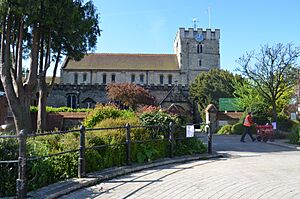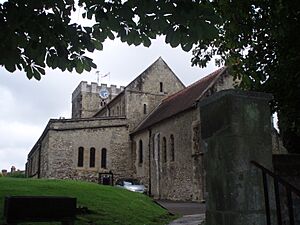St Peter's Church, Petersfield facts for kids
St Peter's Church is a historic church in Petersfield, Hampshire, England. It's part of the Anglican faith, which is a Christian church. This old building is a Grade I listed building, meaning it's very important and protected. It stands right in the middle of Petersfield, on the south side of the town square. A famous architect named Nikolaus Pevsner once said it was "one of the most interesting churches in Hampshire."
Contents
History of St Peter's Church
St Peter's started as a small chapel, built in an open area called 'St. Peter's in-the-veld'. It was part of a larger church area called Buriton. Even though Petersfield grew much bigger, St Peter's stayed a chapel until 1886. That's when it became its own separate church parish. Since 1984, the same Vicar (church leader) looks after both Petersfield and Buriton churches.
The church was first built in the Norman style, which was popular around the 11th and 12th centuries. Later, in the late 1100s, extra parts called north and south aisles were added. The tower was made taller in the 1300s, and a decorative top was put on it. In the 1400s, new windows with special Perpendicular designs were added.
In 1873, the church had a big restoration (a major repair and update) led by an architect named Sir Arthur Blomfield.
St Peter's was closed for a while starting in October 1998. This was for a big project called 'St Peter's 2000 Project'. They did a lot of work to restore and rearrange the inside of the building. The church was officially reopened by the Bishop of Portsmouth on October 1, 1999.
Exploring the Church Building
St Peter's Church was first built in a cruciform shape, like a cross. A tower was added soon after it was built. The arch leading into the main part of the church (the chancel) has parts from the original building and from the 1873 restoration. The church has two side sections called transepts. The south transept was once used as a small chapel. It even has a 13th-century piscina, which is a basin used for washing sacred vessels. Each transept has different designs on the tops of its pillars.
The Jolliffes, a local important family, used to have their own special seating area in the south-west corner of the church. In 1962, there was a fire, and the wooden roof above the south side aisle had to be replaced.
Church Dimensions
The chancel, which is the area around the altar, is about 9.75 meters long and 4.27 meters wide. It has modern rooms for the clergy and the organ on its north side. The main part of the church, the nave, is about 18.59 meters long and 5.03 meters wide. It has north and south aisles, which are about 4.87 meters and 5.18 meters wide. The tower at the west end is about 5.02 meters by 5.18 meters.
The Chancel Area
At the east end of the chancel, there are three modern windows that look like they are from the 12th century. These replaced an older window from the 1400s. On the north wall, there's an old round-headed window from the late 1100s, but it's now covered by the roof of a modern room.
The nave is the main part of the church where people sit. It has rows of arches on both sides. The arches on the east side are wider than those on the west. All the arches are round-headed. The columns supporting the arches are round on the north side. On the south side, the columns are square with rounded corners, and they are older. The tops of the columns (capitals) have different designs.
Some of the pillars on the north side have been changed and moved. However, the two western pillars and the end pillar on the south side are still in their original spots. The upper part of the nave walls, called the clerestory, was added in the early 1900s. It has pairs of round-headed windows.
The Church Tower
The west tower has four levels. The very top level was built in the 1400s. It has battlements (like a castle wall) and windows with two lights for the bells. The lower three levels of the tower are from the 1100s. There's a staircase at the southwest corner that you can enter from outside the church. Inside, on the ground level, there's a wide, round arch from the early 12th century. Above it, there's another round opening that likely led to the roof of the early nave.
The Church Bells
The tower holds eight bells that are used for traditional English Change Ringing. This is a special way of ringing bells in a changing pattern. The oldest bell was made in 1750 by Robert Catlin. The largest bell, called the Tenor bell, was made in 1770 and weighs about 790 kilograms (that's almost as much as a small car!). It's tuned to the note F. St Peter's has a very active group of bell ringers, with over 30 members of all ages.
| Bell | Weight | Note | Date | Founder |
|---|---|---|---|---|
| 1 | 222kg | F | 1978 | Whitechapel Bell Foundry, London |
| 2 | 237kg | E | 1978 | Whitechapel Bell Foundry, London |
| 3 | 268kg | D | 1895 | John Taylor & Co, Loughborough |
| 4 | 280kg | C | 1750 | Robert Catlin, Holborn |
| 5 | 313kg | B♭ | 1976 | Whitechapel Bell Foundry, London |
| 6 | 465kg | A | 1905 | John Taylor & Co, Loughborough |
| 7 | 600kg | G | 1895 | John Taylor & Co, Loughborough |
| 8 | 790kg | F | 1770 | Pack & Chapman, Whitechapel, London |
Inside the Church
The Font
The font, which is used for baptisms, dates back to the 15th century. It was replaced in 1873 and sat in the churchyard for 70 years before being brought back and restored.
The Organ
The church's organ was replaced in 1992 by Lammermuir Pipe Organs. There are also beautiful stained glass windows. One window remembers Bishop Samuel Wilberforce, and another honors Mary Sumner, who started the Mothers' Union.
The Altar
The altar, the table where communion is held, was made by a well-known craftsman named Edward Barnsley.
Memorials
On the south wall, there's a brass plaque honoring Petersfield's only VC winner, Loftus Jones. The Victoria Cross is the highest award for bravery in the British armed forces. In the north aisle, there are two more brass plates. One is for Anne Holt from 1655, and the other is for Dr. Thomas Aylwin (1704) and his wife Mary (1693). Many other memorials have been moved to the far south of the church, some into new rooms.
The Churchyard
The churchyard, the area around the church, is mostly on the south side. It has a gate on the east. Records show that steps, a wall, and a gate were added on the east side of the churchyard in 1754. This was so the local squire, William Jolliffe, and his family could enter the church more privately.
Church Leaders (Vicars) of Petersfield
St Peter's Church has had many vicars (church leaders) over the years. Here are some of the more recent ones:
1845-1886: John Maunior Sumner
John Maunior Sumner was the vicar for many years. There is a memorial to him above the main entrance of the church.
1886-1909: Francis Jervoise Causton
Francis Causton was educated at Bradfield College and University College, Oxford. Before coming to Petersfield, he was the Vicar of All Saints in Alton. After leaving Petersfield, he became the Master of St Cross Hospital, an old almshouse near Winchester.
1909-1914: Archdall Malden Hill
Archdall Hill studied at Blundell's School and Sidney Sussex College, Cambridge. He served in other churches before coming to Petersfield. He became good friends with Leonard Hedley Burrows, who later became the first Bishop of Sheffield.
1914-1921: William Henry Thomas
William Thomas trained at Sarum College. He was the Vicar of Privett before his time at St Peter's and later became the Rector of West Meon.
1930-1950: Elliot Charles Archer Kent
Elliot Kent studied at the London College of Divinity. He arrived at Petersfield in 1930 after being the Vicar of St Matthew in Gosport for ten years. He was also a governor of Churcher's College and led the Diocesan Bell Ringing Society.
1951-1959: Frederic Walter Hadfield
Frederic Hadfield became a priest in 1937. He served as a navy chaplain during World War II. He was the Rector of Botley before coming to St Peter's.
1970-1990: Ronald Harry Granger
Ronald Granger studied at Selwyn College, Cambridge. He worked in churches on the Isle of Wight before his years at Petersfield.
1999-2010: Giles Harris-Evans
Giles Harris-Evans was the Vicar from 1999 to 2010. His career took him to many different places around the world, including Bangalore and Sri Lanka. After retiring, he has continued to help the church, even working as a human rights observer in Palestine.
2011-Present: Will Hughes
Will Hughes has been the Vicar since 2011. He studied at Exeter University and Ripon College Cuddesdon. Before coming to Petersfield, he was the Vicar of Blackmoor with Whitehill.




